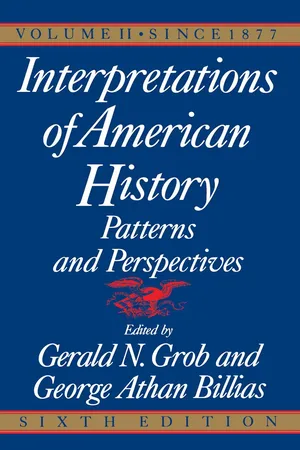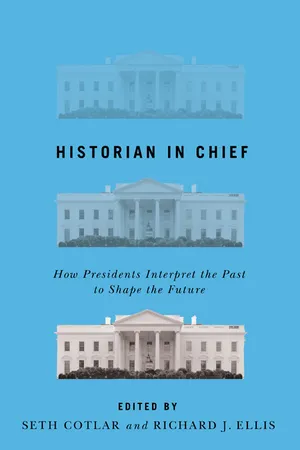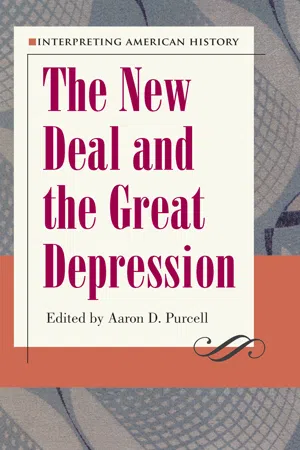History
Legacy of the New Deal
The legacy of the New Deal refers to the lasting impact of the comprehensive set of economic and social programs implemented by President Franklin D. Roosevelt in response to the Great Depression. The New Deal's legacy includes the establishment of Social Security, labor rights protections, and infrastructure development, shaping the role of the federal government in addressing economic challenges and promoting social welfare.
Written by Perlego with AI-assistance
Related key terms
4 Key excerpts on "Legacy of the New Deal"
- eBook - ePub
- Gerald N. Grob, George Athan Billias(Authors)
- 2010(Publication Date)
- Free Press(Publisher)
In a study of Boston during the 1930s, Charles H. Trout observed that the “New Deal’s manifestations were treated piecemeal and were perceived by individuals and groups according to their particular needs.” Indeed, many federal programs involving social and economic change were resisted by Bostonians precisely because of the weight of tradition and history; the concept “of a national or even a municipal communality of interest was seldom grasped.” 21 From a local perspective, therefore, the accomplishments of the New Deal were limited and more remote. The problem of understanding and assessing the achievements of the New Deal and its place in American history, therefore, is one whose answer will largely be shaped by a series of prior assumptions about the nature of the American past and the nation’s ideals in both the present and future. To those historians whose view is that America is founded upon an atomistic philosophy—that the nation’s greatness arose from the achievements of talented and ambitious individuals and was not always related to the activities of government—the New Deal will always appear as a movement alien and hostile to traditional values. In this context the New Deal represents a new departure in American history that will end in a collectivistic and authoritarian government. On the other hand, to those scholars who adhere to a corporate philosophy—that society is more than a mere aggregate of private individuals and that a modern complex industrial economy requires a certain amount of public regulation as well as government-sponsored reform—the New Deal becomes a political movement inspired by proper ideals. Instead of representing an aberration in terms of the American political tradition, the New Deal was a movement consonant with previous struggles for justice and equality - eBook - ePub
Historian in Chief
How Presidents Interpret the Past to Shape the Future
- Seth Cotlar, Richard J. Ellis(Authors)
- 2019(Publication Date)
- University of Virginia Press(Publisher)
35Such steps were intended, in the words of Roosevelt that Obama endorses, to ensure “freedom from want” and “freedom from fear.”36 Although accomplishing all of that took not just a couple of years but most of Roosevelt’s four terms in office, and necessitated very skillful negotiating with adversaries within as well as outside his own party, the accomplishments of the New Deal nevertheless fell far short of Roosevelt’s ultimate goals, a second Bill of Rights, on which he campaigned successfully for reelection in 1944. These programs did establish a precedent, however—the legitimacy of social provision—that enabled later generations to extend those principles and expand the range of Americans covered by those programs. Obama reports in The Audacity of Hope that he carried with him similar aspirations as he entered the U.S. Senate.37 Although he made clear that his goals did not change after his election in 2008, he had few opportunities to make progress toward them after the election of 2010.During his presidency, Obama repeatedly emphasized the responsibility of the federal government to return to its earlier practice of regulating the American financial sector. It has become clear to many observers that the bipartisan mania for deregulation during the 1990s helped usher in the worst economic crisis since the 1930s. Obama pledged to address the problems caused by that deregulation, and he brought Sunstein, Tribe, and Elizabeth Warren to Washington to help spearhead the effort. If the founders were right to believe—as did progressives, New Dealers, and champions of the Great Society, and as Obama himself wrote in The Audacity of Hope that he believes as well—that democracy requires at least rough economic equality, then the United States for several decades has been slipping steadily away from one of its central animating principles. Whatever Obama’s own legacy proves to be, he patterned his diagnosis of the problems of financial malfeasance and his initial proposals for its solution in The Audacity of Hope after those of the progressives and New Dealers who constructed the regulatory apparatus that has been largely dismantled since 1980.38 - Aaron D. Purcell(Author)
- 2014(Publication Date)
- The Kent State University Press(Publisher)
First, scholars questioned who was responsible for the reforms of the New Deal, with one group maintaining that Roosevelt and his advisors were the key and, and another arguing that the people generally, rather than Roosevelt and his advisors, were the chief instigators in identifying areas for reform. Second, scholars have either interpreted the 1930s as a period of American liberalism in which the New Deal was the engine for change, or they have viewed the New Deal as a conservative moment when government officials sought to appease business, labor, and popular demands for change. As a result, one group of historians portrayed Roosevelt as a near socialist, while other scholars argued that Roosevelt took steps to save capitalism. Finally, scholars have searched for New Deal connections to other reform movements, especially focusing on the Populist Movement of the late nineteenth century, the Progressive Era of the early twentieth century, and the Great Society programs of the 1960s. 10 Historians have argued variously that the New Deal went too far, that it did not go far enough, that it created more problems than it solved, or even that its shaky foundations are the reason for the economic and social instability of the Great Recession of the early twenty-first century. The varied scholarship on the New Deal and the Great Depression presents an example of how historical interpretation changes over time. One constant across all these studies is the importance of historical revisionism, or the re-examination of previous historical interpretations. The corpus of scholarship on the New Deal and the Great Depression fits well within a few major categories, or schools, of historical interpretative thought that developed. It is important to remember that scholars representing these schools of thought wrote across a wide period of time and their interpretations changed over the decades- eBook - ePub
Social Solutions to Poverty
America's Struggle to Build a Just Society
- Scott Myers-Lipton, Charles C. Lemert(Authors)
- 2015(Publication Date)
- Routledge(Publisher)
38The New Deal policies had a profound impact on the nation, as they fundamentally changed the relationship between the federal government and its citizens. The federal government had adopted the sociological perspective that one’s destiny is not solely determined by one’s effort, but that social factors beyond one’s control play an important, if not decisive, role. Since these social factors were national in scope, the federal government had a responsibility to intervene and help solve the problem. Of course, this required the government to become deeply involved in the economy and the lives of its citizens, which led to an expansion in the size and scope of the federal government. This also led to an enormous increase in the resources spent on public assistance. For example, in 1913 and 1923, the federal government spent only 1 percent of the budget on public aid; in 1933, it had increased to 7 percent and by 1939, it spent 27 percent.39Yet, with such a transformation, the New Deal was not successful in ending the depression. In 1939, six years into the New Deal, unemployment was still at 17 percent. Although the WPA employed three million people a year, there were another ten million people who needed jobs. The Economic Security Act, as highlighted by the earlier analysis of the Lundeen bill, revealed the deficiencies of the New Deal. Roosevelt’s “cradle to grave” security system had developed into a patchwork of programs that left many people in need without the necessary support. Public assistance was not based on need, but rather was dependent on which state the individual lived in, how long she had lived in that state, how much he had made in his previous job, or a particular characteristic, such as age or race. At the same time, it maintained the belief that there were the deserving and undeserving poor, who warranted different treatment and benefits.40
Learn about this page
Index pages curate the most relevant extracts from our library of academic textbooks. They’ve been created using an in-house natural language model (NLM), each adding context and meaning to key research topics.



